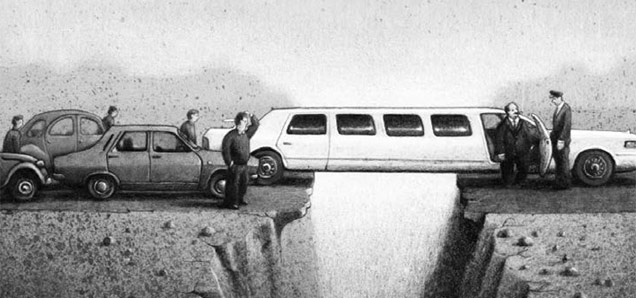ARTiculation: The process of creation
 CREDIT: PAWEL KUCZYNSKI
CREDIT: PAWEL KUCZYNSKIPawel Kuczynski�s Trouble is ripe with symbolism.
My daughter was two years old when she escaped her stroller, toddled up to a very famous painting at the National Art Gallery, and reached out. It was like a slow motion scene out of a movie as I turned around and saw her chubby little hand getting closer to the canvas. My eyes widened and mouth fell open as I stumbled to try and intercept her hand on the way to the painting. But despite my efforts, her banana-y fingers landed on the immaculate paint, like the first step on the moon. We were promptly escorted out. If you're not allowed to touch art, what is the significance of the medium chosen? Why do people choose bumpy or smooth paint, music, writing, or sculpture over the others?
Conceptual art is the practice of creating pieces by placing attention on both the planning and execution of a piece. Often, conceptualism is used to portray a very specific message to the audience. For example, Pawel Kuczynski creates surreal, even cartoonish paintings of satirical scenarios. One of his better known works is an image of a deep cavern that needs to be crossed, with a group of economy cars stopped trying to figure out how to cross it, and a limo stretching right over it with a rich man getting out on the other side. Symbolism is pertinent to conceptual art, and the process of creation can be used as another tool to demonstrate the intent of the finished piece. Further, the carefully planned steps of the process, be it sketching, layout, medium choice and canvas choice, can be a symbolic action that embodies or accentuates the meaning.
There are many artists who use medium choice as a powerful tool in portraying their desired result. Among them is ambitious paper artist Jen Stark. Stark uses paper, scissors and glue to create large-scale pieces of work. She uses paper — her medium — because it is a regular element of our daily lives that is dismissed as common. She is also inspired by the outdoors, with many of her paper sculptures resembling trees and other parts of the natural world. Her choice of medium is symbolic of her purpose for creating the pieces because like paper, nature is a part of everyone's daily life — it's everywhere — but we often overlook it in our haste. How the medium is used is also symbolic. Her pieces are very intricately cut, accentuating the complexity of our world. “I love how nature is a vast unknown that we have barely begun to understand. I hope to evoke a similar feeling of awe and mystery in my artwork.” At every step, her process illustrates a belief she has about her subject: nature.
The conceptual element of art is important to recognize if you're trying to visually portray an idea. The work is most successful if the symbolism is seamlessly sewn into every facet of the piece. It should be multi-dimensional, not necessarily in physical form, but in the thorough consideration of steps and how an artist can make each one align with the objective. The medium can become the message.
Editorial opinions or comments expressed in this online edition of Interrobang newspaper reflect the views of the writer and are not those of the Interrobang or the Fanshawe Student Union. The Interrobang is published weekly by the Fanshawe Student Union at 1001 Fanshawe College Blvd., P.O. Box 7005, London, Ontario, N5Y 5R6 and distributed through the Fanshawe College community. Letters to the editor are welcome. All letters are subject to editing and should be emailed. All letters must be accompanied by contact information. Letters can also be submitted online by clicking here.













